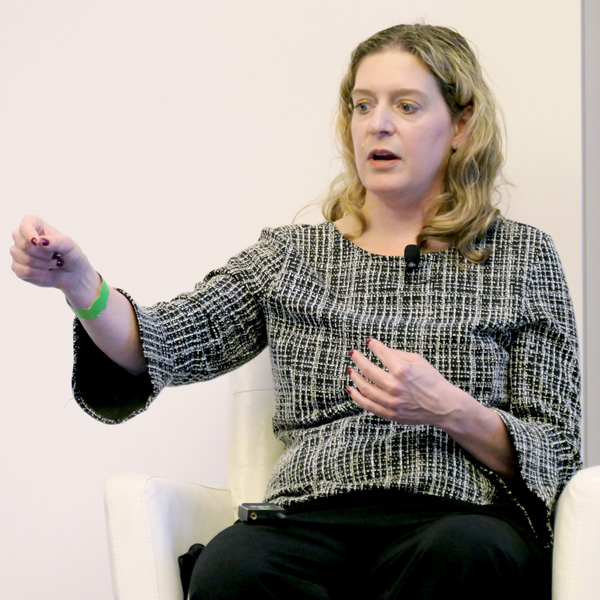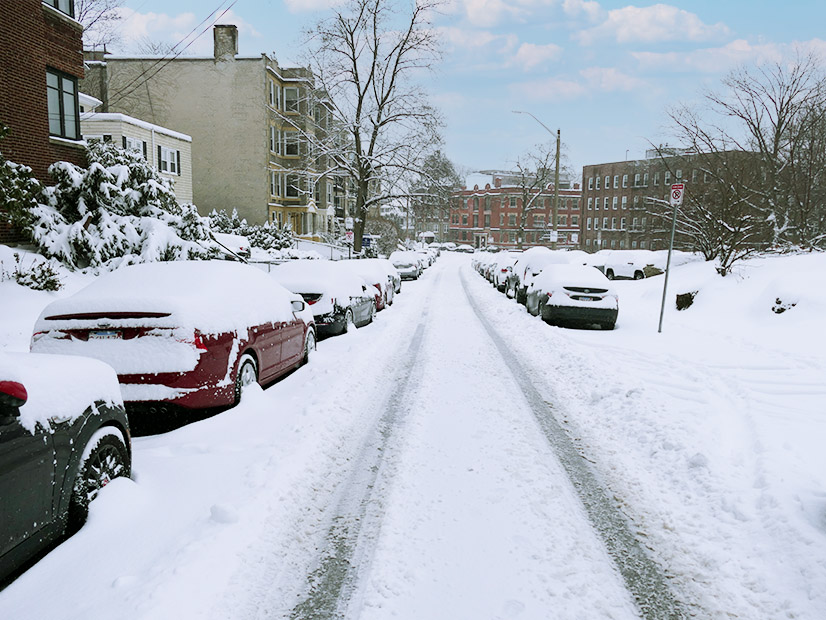“If you don’t like the weather in New England now, just wait a few minutes,” goes a saying attributed to Mark Twain.
State officials and grid operators in New England are seeing more and more weather they don’t like, but they don’t have a few minutes to wait. In the wake of last year’s crisis in Texas, and with the growth of renewable energy technology reliant on fluctuating sunlight and wind, weather and forecasting have turned into something of an obsession in the region.
In Massachusetts, state officials started having weekly meetings this winter to pore over the latest data from ISO-NE, paying close attention to weather and load forecasts and oil reserves.
 Patrick Woodcock, commissioner of the Massachusetts Department of Energy Resources | © RTO Insider LLC
Patrick Woodcock, commissioner of the Massachusetts Department of Energy Resources | © RTO Insider LLC
“I’m one of those people that never watches the weather,” said Patrick Woodcock, commissioner of the Massachusetts Department of Energy Resources. “But I have never paid more attention to the weather than this winter.”
Before the winter started, ISO-NE turned a spotlight on the weather, warning that extended cold snaps could lead to blackouts in the region this year.
“Watching what played out in Texas, and realizing that most people in this region don’t understand how vulnerable we are when it gets cold, we thought that it’s time for us to start communicating more openly about these risks,” CEO Gordon van Welie told reporters in December. (See ISO-NE: New England Could Face Load Shed in Cold Snaps.)
So far, New England has dodged a bullet, with limited cold weather and only a few brief moments of strained conditions on the grid, but the worries haven’t gone away.
“We can’t control the weather, and we can’t always see it coming early enough to react to it,” ISO-NE spokesperson Matt Kakley said. “It’s outside of our control. So we are focused on it, and that’s why we want to make sure people understand the conditions under which we’re most at risk.”
Changing Weather, Growing Challenge
Part of the difficulty of adjusting to weather is that it’s changing significantly as the planet warms.
 Jason Shafer, atmospheric sciences professor at Northern Vermont University | © RTO Insider LLC
Jason Shafer, atmospheric sciences professor at Northern Vermont University | © RTO Insider LLC
Much of the research into the effects of climate change on storms has focused on hurricanes, but blizzards in the Northeast are changing too, said Jason Shafer, a professor of atmospheric sciences at Northern Vermont University.
“Warmer and wetter climates mean that more snowstorms are going to be closer to freezing,” Shafer said at a recent renewable energy conference in Boston. “More wet snow causes more grid impacts.”
Those more intense storms are windier too, and wind is one of the biggest hazards for grid reliability, he said.
“Our climate is relatively resilient in the Northeast … but the risks are going to get stronger because of extreme weather becoming a little stronger,” Shafer said.
It’s a problem that ISO-NE has recognized in its rhetoric, and on which it’s starting to take action.
“It’s obvious that climate change is producing more volatile weather and extreme weather, and we need to factor that into our planning,” Kakley said.
The grid operator, again motivated by events in Texas and California, recently launched a study on the operational impact of extreme weather events, in partnership with the Electric Power Research Institute.
The probabilistic energy security study will use climate data to model extreme weather and its impact on the grid, employing ISO-NE’s 21-day energy forecast tool.
“Extreme weather events in Texas and California have made it apparent that multiday or longer energy deficiencies have serious consequences to residents and the economy,” ISO-NE said in its description of the project.
The Solar Question
The other big factor that has the grid operator paying increasingly closer attention to the weather is the influx of renewable resources to the region, which see their output shift based on even small fluctuations in sunlight, the wind or precipitation.
 Jennifer Schilling, vice president of grid modernization at Eversource Energy | © RTO Insider LLC
Jennifer Schilling, vice president of grid modernization at Eversource Energy | © RTO Insider LLC
“The power flows on the system are changing very rapidly, so you need, for instance, to know if it’s a cloudy day; are we going to have a thunderstorm that’s going to come in; when is it going to be sunny?” said Jennifer Schilling, vice president for grid modernization at Eversource Energy. “What it took to operate the system even five or 10 years ago is very different than what it takes today.”
The patterns of solar in particular have vexed grid managers in California and elsewhere, and New England isn’t immune to the now well known “duck curve” problem, which causes unique patterns of energy demand to navigate. (See New England’s Duck Curve Days Chart Solar Growth.)
Renewable generators are also inherently more vulnerable to certain weather impacts. In Vermont, for example, solar panels lose about 5 to 10% of their effectiveness from snow cover, Shafer said. “This is a hard problem. Just a little bit of snow on a solar panel … is a big deal.”
Kakley noted that as more and more solar comes onto the grid, the consequences of changes in weather grow.
“A 10% increase in clouds might be a 400-MW drop in production. We need to be prepared to make up for that in other resources,” Kakley said. “It’s trying to get more information; better information; more accurate information. When you talk to the forecasters and the control room, more information is always going to help them do their jobs better.”
There’s increasingly powerful technology that can help bring in that information, such as sky imagers that can help with hourly forecasts; better satellite data for hours-ahead predictions; and weather forecast models for day-ahead looks at the conditions.
“We can do this. There are tools out there,” Shafer said. “I think there’s a lot of opportunity, a lot of dots we need to connect.”
ISO-NE, which already contracts with four forecasting companies to get weather information and also employs its own meteorologist to track weather impacts on the grid, is looking to boost its capabilities.
In a recent budget report to federal regulators, the grid operator said that it is expanding its forecasting to 23 cities from the current eight and adding two new “weather concepts” to its forecasts to get more granular information. It’s also bringing on new vendors to add to its behind-the-meter solar PV forecasts.
“The science behind forecasting has improved, and we want to make sure we’re using the best software available,” Kakley said.



